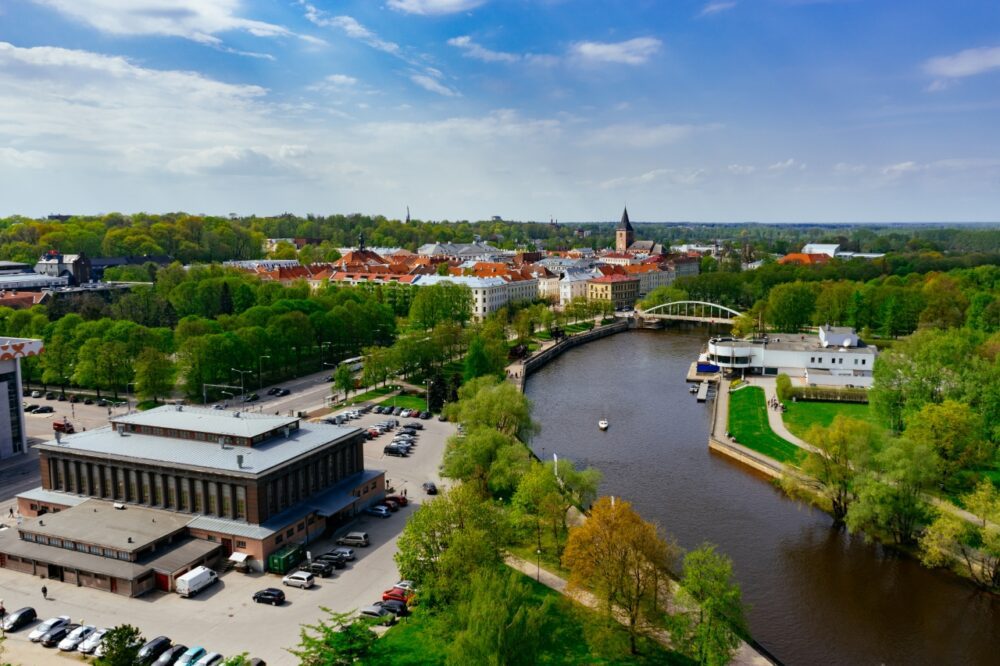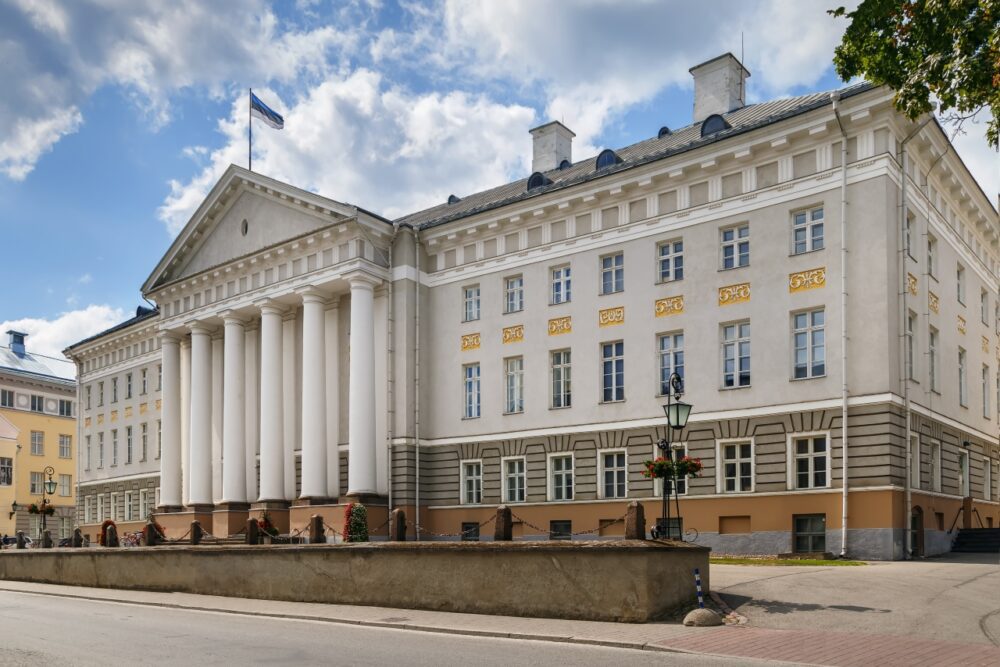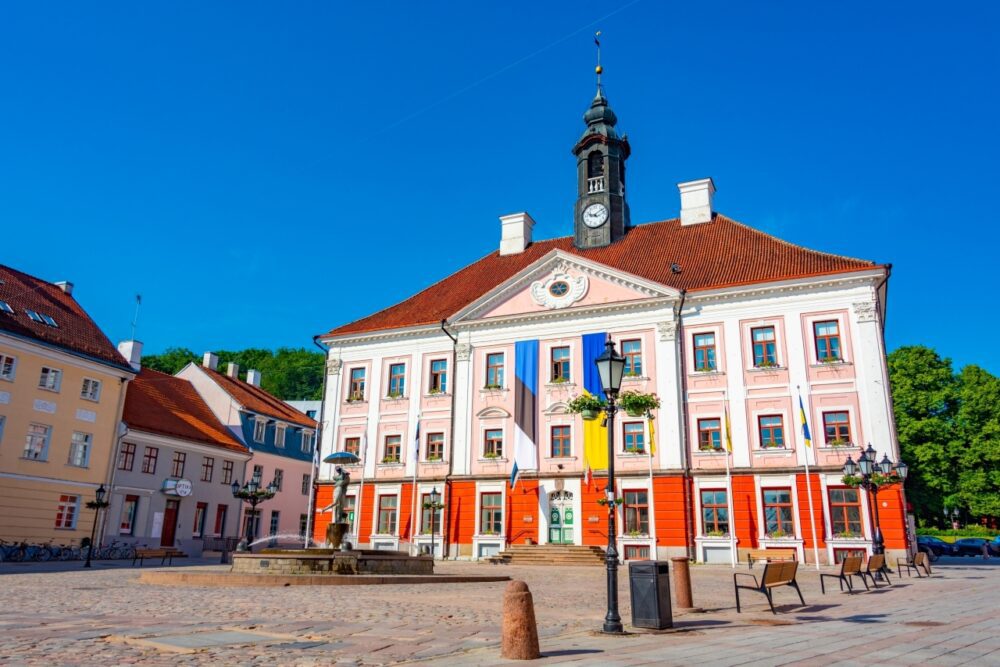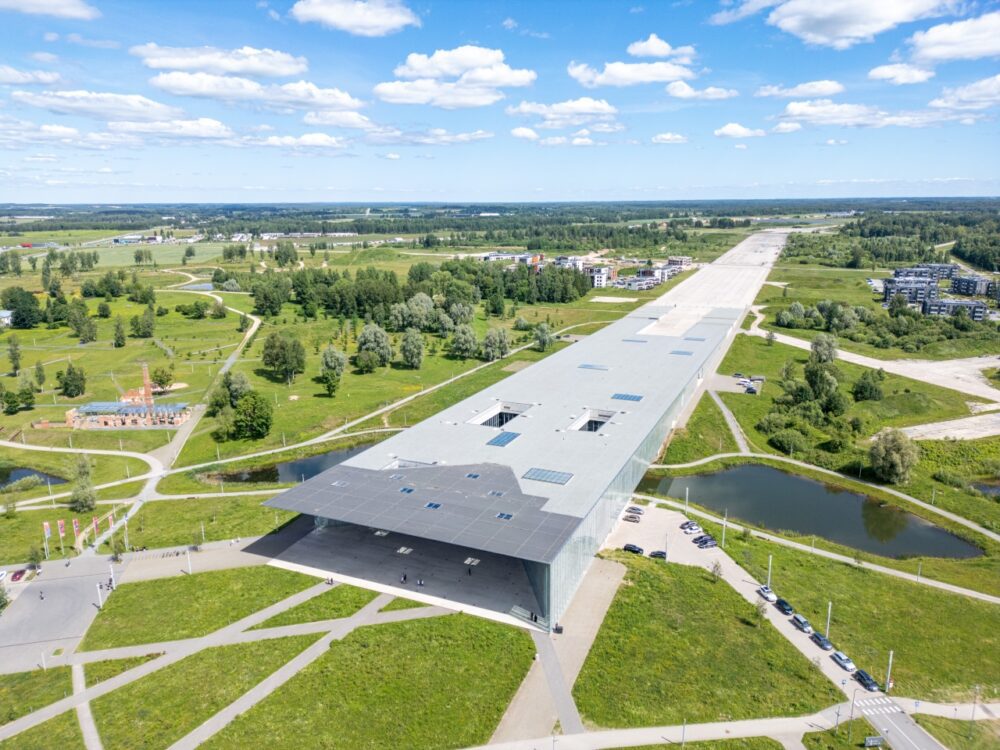
Is Tartu worth visiting? Absolutely! The first time I visited Tartu, I was immediately struck by its youthful energy and intellectual vibe. Known as the country’s “City of Good Thoughts,” Tartu has a charm all its own, thanks to its rich history, lively student population, and welcoming atmosphere. Wandering through its streets, I found myself captivated by the perfect mix of culture, innovation, and small-town charm.
Tartu, the second-largest city in Estonia, is home to one of Europe’s oldest universities, giving it a reputation as the intellectual and cultural heart of the country. It’s a place where history meets creativity—think charming cobblestone streets lined with colourful 18th-century buildings alongside cutting-edge museums and quirky art installations. Whether you’re exploring the University of Tartu, marvelling at the whimsical statues dotted throughout the city, or relaxing in the scenic parks along the Emajõgi River, Tartu offers an experience that feels both laid-back and inspiring. But is Tartu worth visiting for you?
In this blog post, we’ll uncover the top 10 reasons why Tartu should be on your travel list, from its fascinating landmarks to its vibrant cultural scene. We’ll also share travel tips to help you make the most of your visit. Keep reading, and you’ll discover why Tartu is one of Estonia’s most delightful hidden gems.
Table of Contents
Pros – Reasons You Should Visit Tartu
1. A Historic and Intellectual Atmosphere as Estonia’s University City

Tartu is often called the intellectual and cultural heart of Estonia, largely due to the presence of the University of Tartu, one of the oldest universities in Northern Europe. Founded in 1632, the university gives the city a vibrant academic atmosphere, with a strong emphasis on history, innovation, and youthful energy. Walking through the city, you can feel the influence of students and scholars, which makes Tartu a dynamic yet relaxed place to visit.
I spent time exploring the university’s main building, a beautiful neoclassical structure that feels like the centerpiece of the city. The atmosphere reminded me of a smaller version of Cambridge or Heidelberg—charming, historic, and full of people deep in discussion at cafés and bookshops. The university also has a fascinating museum inside the old cathedral ruins on Toome Hill, which offers an incredible look at Estonia’s academic history. Whether you’re interested in history, literature, or philosophy, Tartu is a place where ideas thrive.
2. A Compact and Walkable City with a Laid-Back Vibe

Unlike larger European cities that require extensive public transportation, Tartu is compact and very walkable, making it an easy place to explore on foot. The city center is well-designed, with beautiful pedestrian streets, open squares, and charming riverfront paths that make wandering around a pleasure.
I loved strolling along the Emajõgi River, which runs through the city, offering scenic views and a peaceful atmosphere. The main town square, Raekoja plats, is a great place to start, with its historic buildings and colorful, well-preserved architecture. Because everything is close together, you never feel rushed or overwhelmed, making Tartu the perfect destination for those who enjoy relaxed, stress-free travel.
3. The Iconic Leaning House and Raekoja Plats
One of the most famous landmarks in Tartu is the Leaning House, a historic building that visibly tilts due to unstable foundations. Often compared to the Leaning Tower of Pisa, it’s a quirky sight in the city center and now houses the Tartu Art Museum, adding an artistic touch to its historical appeal.
The Leaning House sits in Raekoja plats, the central square of Tartu, where you’ll find the Town Hall, the famous kissing student fountain, and a lively mix of cafés and restaurants. When I visited, the square was buzzing with activity, from street musicians to open-air markets. It’s the kind of place where you can sit with a coffee and soak in the city’s atmosphere while watching locals go about their day.
4. A Thriving Arts and Alternative Culture Scene
Tartu has a strong creative spirit, and its arts and alternative culture scene is one of the most vibrant in Estonia. You’ll find colorful street art, experimental galleries, and a strong presence of independent artists who give the city a unique and slightly bohemian feel. The city embraces both classical and contemporary art, with many museums, workshops, and festivals celebrating different forms of creativity.
One of the best places to experience this side of Tartu is Aparaaditehas, a former factory that has been transformed into a cultural space filled with art studios, design shops, cafés, and live music venues. I loved the mix of industrial aesthetics and modern artistic expression—it’s the kind of place where you can spend hours exploring and still feel like you’ve only scratched the surface. If you enjoy discovering local art scenes, Tartu is full of surprises.
5. Tartu Cathedral and the Views from Toome Hill

Tartu Cathedral, or what remains of it, is one of the most fascinating historical sites in the city. Originally built in the 13th century, the cathedral was heavily damaged over the centuries, and today, its red brick ruins stand as a dramatic reminder of the past. Despite its ruined state, the cathedral is still an impressive landmark, and the University of Tartu Museum is housed within its remaining structures.
I climbed up Toome Hill, where the cathedral sits, and was rewarded with beautiful views of the city. The park surrounding the ruins is a peaceful place to walk, with winding paths, historic bridges, and scenic viewpoints. Whether you’re interested in medieval history or just looking for a great spot to take photos, this area is one of Tartu’s highlights.
6. A Relaxed Café Culture with Great Local Coffee
Tartu has an excellent café culture, with plenty of cozy, independent coffee shops that serve locally roasted coffee and homemade pastries. The city’s student population has helped create a strong café scene, where people gather to study, read, or simply enjoy a slow afternoon with a good cup of coffee.
I spent time at Karlova Kohv, a laid-back café in one of Tartu’s bohemian neighborhoods, and it quickly became one of my favorite spots in the city. The atmosphere was warm and inviting, with shelves full of books and a steady stream of locals catching up over coffee. If you enjoy spending time in charming, character-filled cafés, Tartu has plenty of hidden gems waiting to be discovered.
7. The National Museum of Estonia is a Must-Visit

The Estonian National Museum, located just outside the city center, is one of the most impressive museums in the country. The museum focuses on Estonian history, culture, and identity, with fascinating exhibits covering everything from prehistoric artifacts to the country’s Soviet past and eventual independence.
What stood out to me most was the museum’s modern design—its architecture is striking, with a sleek, minimalist structure that feels futuristic yet blends well with its surroundings. The interactive exhibits make it an engaging experience, even for those who aren’t usually museum enthusiasts. If you want to understand Estonia beyond the usual tourist sites, this museum is a must-visit.
8. A City That Celebrates Festivals and Events Year-Round
Despite its small size, Tartu hosts numerous festivals throughout the year, ranging from music and art to science and film. Some of the most popular events include the Tartu Love Film Festival, the Tartu Hanseatic Days, and the Prima Vista Literary Festival. The city also plays host to academic conferences and cultural gatherings that attract people from around the world.
I happened to visit during the Student Days festival, a lively event full of concerts, theater performances, and quirky student traditions. It was amazing to see the city come alive with celebrations, and it made my visit feel even more special. Checking the festival calendar before visiting is a great way to make sure you catch some of Tartu’s unique cultural experiences.
9. The Scenic Emajõgi River and Riverside Walks
The Emajõgi River runs through Tartu, adding to the city’s natural beauty and offering great opportunities for scenic walks, boat tours, and waterfront relaxation. The riverside area is beautifully maintained, with pedestrian-friendly paths, small parks, and floating cafés where you can enjoy a drink by the water.
I took a sunset walk along the river, and it was one of the most peaceful moments of my trip. The reflections of the city lights on the water, combined with the quiet hum of people enjoying the evening, made it a perfect way to end the day. If you appreciate cities with a strong connection to nature, Tartu’s riverside charm is a major plus.
10. A Less Touristy, More Authentic Experience
Tartu offers a much quieter, more authentic experience than larger tourist-heavy cities like Tallinn. While it has plenty of attractions, it doesn’t feel overrun with large crowds, overpriced restaurants, or commercialized experiences. Instead, you get to experience Estonia in a more laid-back, everyday setting, where locals are friendly, and the pace of life is slower.
I loved how genuine Tartu felt—there was no pressure to rush from one attraction to the next, and I never felt like I was in a place designed purely for tourists. It’s the kind of city where you can take your time, enjoy small discoveries, and truly connect with the local atmosphere. For those looking for an off-the-beaten-path destination in Europe, Tartu is a fantastic choice.
Cons – Things You Should Consider When Visiting Tartu
1. The Weather Can Be Cold and Unpredictable for Much of the Year
Tartu, like much of Estonia, has a northern European climate, which means long, cold winters and unpredictable weather throughout the year. From late autumn to early spring, temperatures often drop below freezing, and snow can cover the city for months. Even in the warmer months, sudden rain showers and overcast skies are common, which can make outdoor activities less enjoyable.
I visited Tartu in early April, hoping for mild spring weather, but instead, I was met with chilly winds and grey skies. The city’s beauty was still apparent, but spending time outdoors required layering up and being prepared for unexpected rain. If you’re someone who prefers sunny, warm destinations, Tartu might not be the ideal place, especially in the off-season. The best time to visit for more reliable weather is late May through August, when temperatures are pleasant, and the city feels more alive.
2. Fewer Attractions Compared to Larger European Cities
Tartu is a charming and historically rich city, but it is relatively small, and its list of major attractions is not as extensive as larger European capitals like Tallinn, Riga, or Stockholm. While the old town, the university, and a few key museums are fascinating, many visitors find that they can see most of Tartu’s highlights in just a couple of days.
I spent three days in Tartu and felt like I had explored most of what the city had to offer by the end of my second day. While I enjoyed the relaxed pace, I could see how some travelers looking for a packed itinerary might find Tartu lacking in comparison to bigger cities with endless sights, activities, and entertainment options. If you’re planning a longer stay, you may want to combine Tartu with other destinations in Estonia to make the most of your trip.
3. Limited Public Transport and Fewer Direct International Connections
Tartu is easy to navigate on foot, but if you need to travel beyond the city center, public transportation options are somewhat limited. The bus network covers the main areas, but routes can be infrequent, and there is no metro or tram system. Additionally, Tartu does have a small airport, but it offers very few international flights, meaning most visitors will have to fly into Tallinn and then take a bus or train to reach the city.
I arrived in Estonia via Tallinn and took a two-hour bus ride to Tartu, which was comfortable and scenic but required extra planning. If you’re used to cities with well-developed metro systems or international airports with many direct flights, Tartu might feel a bit out of the way. Renting a bike or using taxis can make getting around easier, but those relying solely on public transport may find it less convenient compared to bigger cities.
4. The Nightlife is Quiet Outside of the Student Scene
Tartu has a large student population, which means there are plenty of bars, pubs, and social events catering to young people. However, outside of the university crowd, the nightlife scene is relatively limited, and those looking for big nightclubs or a high-energy party atmosphere might find the options underwhelming. Many bars and clubs cater primarily to students, and outside of peak university months, the nightlife can feel much quieter.
I went out on a weekday evening and found that while there were some lively spots, many bars were half-empty, and most places closed earlier than I expected. While this isn’t necessarily a bad thing—Tartu is more of a relaxed, cultural city than a party destination—those looking for an exciting late-night scene may prefer Tallinn or other bigger cities in the region. If nightlife is important to your travel experience, visiting during the university semester will offer a livelier atmosphere.
5. Fewer English Speakers Compared to Tallinn and Other Major Cities
While many young people and university students in Tartu speak English fluently, older residents and those working in smaller shops, markets, or local businesses may have limited English skills. Unlike Tallinn, which sees a higher number of international tourists and has a larger English-speaking workforce, Tartu still feels more local and less geared towards international visitors.
I had a few situations where I struggled to communicate basic requests at small cafés and stores. While people were friendly and willing to help, there were moments when I had to rely on gestures or Google Translate. It’s not a major barrier, but if you don’t speak Estonian or Russian, be prepared for occasional language challenges, particularly outside of the main tourist areas. Learning a few basic Estonian phrases, such as “Tere” (hello) and “Aitäh” (thank you), can go a long way in making interactions smoother.
When to Visit Tartu
The best times to visit Tartu are late spring (May to June) and early autumn (September), when the weather is mild, and the city’s parks and riverside areas are especially beautiful. These months offer a relaxed atmosphere and fewer crowds, making it ideal for exploring the city’s historic and cultural sites. Summer (July and August) is peak season, with lively outdoor events, open-air concerts, and a vibrant social scene, particularly among the student population. Winter in Tartu, though colder, has a cosy charm—particularly in December, when the Christmas market and festive lights add warmth to the historic centre.
How to Get to Tartu
The nearest airport to Tartu is Tartu Airport (TAY), located about 10 kilometres from the city centre, though flights are limited. Most international travellers arrive via Tallinn Airport (TLL), which offers a wider range of connections through airlines like AirBaltic and Finnair. From Tallinn, Tartu is easily reached by train or bus, with frequent services taking around 2–2.5 hours. The Elron train provides a comfortable and scenic journey, while buses from Lux Express offer regular routes with Wi-Fi and onboard amenities, making the trip easy and enjoyable.
Where to Stay in Tartu
Tartu’s compact layout means that most accommodation is within walking distance of key attractions, with options for every budget:
- Luxury: City Centre – Close to Tartu University and the main square, the city centre is ideal for those wanting to stay near cultural sights and cafes. Consider Hotel Lydia or Antonius Hotel, both offering boutique luxury with modern amenities in historic surroundings.
- Mid-range: Toomemägi Hill – Near Toome Hill Park and a short walk from the centre, this area has a peaceful feel and easy access to Tartu’s sights. Options like Hotel London and Hansa Hotel provide comfortable stays at reasonable prices.
- Budget: Karlova – This bohemian neighbourhood just outside the centre offers affordable stays in a charming setting with wooden houses and art studios. Looming Hostel and TerviseksBBB are great budget options with a social atmosphere.
Getting Around Tartu
Tartu is very walkable, especially in the city centre, where most major sights—including Tartu University, Town Hall Square, and the Estonian National Museum—are close together. For longer distances, the Tartu City Transport system provides convenient bus services throughout the city, with single tickets and day passes available. Tartu also has a bike-friendly infrastructure, with bikes available for rent at several locations, ideal for a scenic ride along the Emajõgi River. Tartu’s public transport and bike routes make it easy to explore the city on a budget, while taxis are available for quicker trips.
How Long to Spend in Tartu
Two days is ideal for exploring Tartu’s main highlights, including the University of Tartu, Toome Hill Park, and the Estonian National Museum. This timeframe allows you to enjoy the city’s cafes, stroll along the river, and soak up the youthful atmosphere. With an extra day, you could visit AHHAA Science Centre or explore Karlova’s artsy neighbourhood. For nature lovers, consider a day trip to Taevaskoja Nature Trails, where sandstone cliffs and forest paths make for a relaxing escape into Estonia’s scenic countryside.
Conclusion
So, is Tartu worth visiting? Definitely! With its rich academic heritage, charming Old Town, and dynamic cultural offerings, Tartu is a city that rewards curious travellers. Highlights like the University of Tartu, the playful sculptures, and the AHHAA Science Centre make it a fascinating and fun destination. While it’s smaller and quieter than Tallinn, its intimate charm and vibrant atmosphere more than make up for it. If you’re looking to experience a different side of Estonia, start planning your trip to Tartu today—you won’t regret it!
